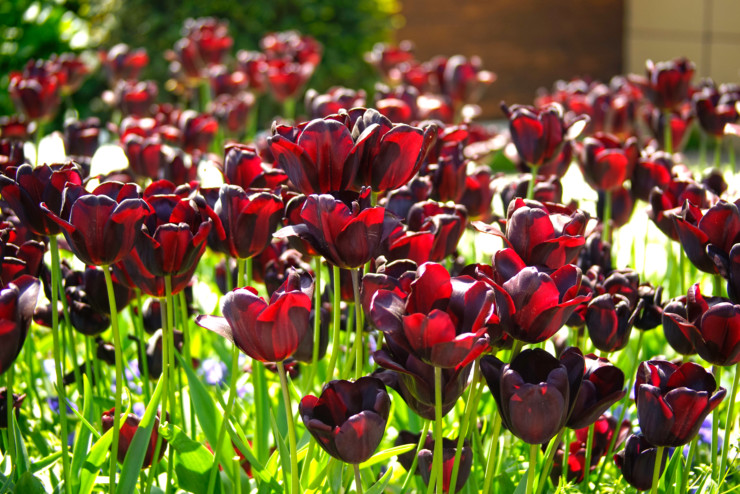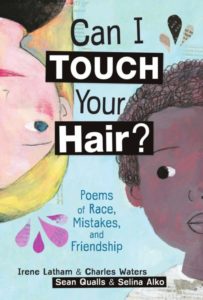Think back to a hard year of school. Were you struggling to fit in? Sweating a project that seemed unclear and unmanageable? Searching for one person you could call a friend?
Irene and Charles know those feelings. When their fifth grade teacher says, “Pick a partner” for a poem project, everyone else buddies up within seconds. They’re stuck with each other, and a little dismayed. They’re so different.
You-never-know-what-he’s-going-to-say Charles, Irene will put in the poem she ends up writing (“The Poem Project”).
Now I’m stuck with Irene? / She hardly says anything, Charles will drop into the poem he ends up writing (“Writing Partner”).
Their classmates ask about the assignment, wanting to know exactly what is expected. How many poems? About what? Do they have to be true? Instead of boundaries, the teacher gives freedom, which does not comfort Irene, as we see at the end of her first poem, “The Poem Project:”
Mrs. Vandenberg
holds up her hand.
Write about anything!
It’s not black and white.But it is.
Charles is black,
and I’m white.
So begins Can I Touch Your Hair? Poems of Race, Mistakes, and Friendship by Irene Latham and Charles Waters, a picture book about an unlikely pair’s developing friendship, told entirely in poems.
Any introvert who’s ever felt a sinking feeling at being assigned group work will feel for Irene. But Charles is glad it’s a writing project. “Words fly off my pen / onto the paper, like writing is my superpower,” he says in “Writing Partner.”
They approach and say hi to each other. He asks what to write about. She shrugs. They stare at their sneakers. He tosses out prompts: shoes, hair, school, church. They agree to start there.
As you might expect, they discover they have more in common than they think. Neither can buy the shoes that catch their eyes; Irene’s mom decrees sensible shoes, while Charles’ dad advises fit and comfort over looks. Both know what it feels like to have people make fun of their hair. To be shunned on the playground by people they thought were friends. To fear a father’s punishment.
As the poems progress, the young writers use that freedom to write about anything to do just that — to explore writing about each other, themselves, their places within their families, their strengths and gifts (writing and reading aloud for Charles, piano playing and horse whispering for Irene), and the complexity of the world they are growing up in.
In the poem “Officer Brassard,” Charles tells of the kind policeman who helped free him when his sneakers got tangled on a chain-link fence and bought him a Popsicle, then tries to reconcile that with news of officers beating and killing “people who could pass as my family.” Irene knows the news is bad “because Papa clicks off / the TV when I walk in,” she writes in “News.” Her father takes her to the park, and after swinging and feeding the ducks, he finally tells her about Ferguson, Missouri.
Charles’ poems are centered, wider, wordier, each written as one long stanza. They often tell a story and include dialogue. Irene’s poems are narrower, usually broken into several short stanzas. Throughout the book, both children explore issues of race. Irene’s shortest poem is on a poignant spread where each child learns about their family’s fears. Though Charles often hangs out at cousin Ronnie’s after school, he can’t go to a sleepover there because “that’s a rough neighborhood, especially at night,” his dad says in “Sleepover.” Irene’s observation has a title as long as its body:
Why Aunt Sarah Doesn’t Go Downtown after Dark
sky
blackstreets
blackfaces
blackfear
white
According to the Authors’ Note, the book began when poet Irene Latham, who is white, invited poet Charles Waters, who is black, “to be a writing partner in a conversation about race.” They got acquainted through a children’s poetry program called Poetry Friday, but they didn’t really know each other. At the time of the book’s publication, they’d never even met. They corresponded through emails, texts and a few phone calls. “It wasn’t until we embarked upon the journey of writing this book that we became friends,” they write.
While they settled on an imagined fifth grade classroom for the book’s setting, they drew on their public school memories to write about experiences both real and imagined. Latham went to elementary school in Folsom, Louisiana; Waters, in Philadelphia. The book’s teacher is based on a real teacher, Becky Vandenberg, who was “a beacon of light” at Charles’ high school in Landsdowne, Pennsylvania.
The paint and collage illustrations were created by husband and wife Sean Qualls and Selina Alko, another interracial team. Their art was also featured in another picture book about friendship — a real-life interracial friendship between Susan B. Anthony and Frederick Douglass. Reading the manuscript by Latham and Waters took them back to their own “hurts, alienations and curiosities” of childhood, they write in the Illustrators’ Note.
We often think of wonder as the birthplace of curiosity. But choosing to move from hurt and alienation to curiosity, rather than to defensiveness or division, often begins with questions. “At home — and in our work — we strive to ask each other questions as a way to try to understand each other’s points of view. It is a constant process of discovery and learning,” the couple say in their Illustrators’ Note. They work to teach empathy and curiosity to their own kids, and to others through their art.
In his poem “Forgiveness,” Charles shows the difference between taunting questions and vulnerable ones, and how one well-timed question can bring about awareness and remorse. In an earlier poem, a new white student, Paul, refused to shake Charles’ hand, and asked him, “Why do you always try to act like one of us?” Here, Paul apologizes for what he said, and tries another handshake.
… I freeze in shock before matching
his extended hand with my own. ‘Wow, thanks, man,’
I say. ‘That means a lot. I’m curious, though,
what made you apologize to me?’ ‘Well,’ he says,
‘Last week a couple of African Americans
asked me the same question I asked you.’
In “Apology,” shy Irene reconciles with a classmate, too — with each of them slipping a note of apology into each other’s library books.
In “Quiet Time,” Irene’s last poem, “For the first time ever, / I take a seat beside Charles.” Across the page, in the illustration for Charles’ poem “Blooming Flower,” collaged words spill out of them like vining blossoms. And he documents another first for Irene: Mrs. Vandenberg, with a smile, asks her to be quiet.
Think back to an unlikely friendship. Where did it start? Was there resistance? What questions served as a handshake?
In their respective Notes, the authors “hope you will find the courage in these pages to have your own conversations about race.” The illustrators hope the book “may ignite conversations about race and identity — conversations that aren’t so easy to have but are necessary to gain greater understanding.”
I wonder, why not also hope that some of these conversations will take place through the work of exchanging poems or collaborating on a creative project?
In reading this book, I thought of the college students I teach, especially the driven, high-achieving engineering and premed majors, who were similarly dismayed at the freedom and invitation I gave on some of their assignments, instructing “follow your curiosity” instead of providing a “do exactly this” rubric. And I’m heartened by comments in their end-of-semester reflections — I wish I’d taken this class sooner; I was dreading this but ended up enjoying it; I’m proud of what I wrote, thanks for letting me explore.
I think, too, of relationships, years ago and even now, that I might initially have felt like withdrawing from, over differences of race or faith or political views or age or some other difference, or even a misunderstanding. In the ones that grew (sometimes through writing rather than in-person conversation), it often took a moment of standing on our common ground, looking up from my shoes to the person before me, venturing a question, and listening. And then opening up when a question was returned to me.
Photo by Blackhawk Photography – Fırat KARAŞAHİN, Creative Commons, via Flickr. Post by Laura Lynn Brown.
- Pandemic Journal: An Entry on Pencil Balancing - August 4, 2020
- Between Friends: Wordplay and Other Playful Bonds - July 25, 2019
- The Power of Curiosity: “Can I Touch Your Hair?” by Irene Latham & Charles Waters - May 29, 2019


L.L. Barkat says
I love this:
“to be a writing partner in a conversation about race.”
There could be so many such partnerships across a range of experiences and issues. I would love to see it (and it would be an interesting shift from the hit-and-run type interchanges that too often seem to rule the Internet).
Thanks for bringing this book and its inspiration to us! 🙂
Laura Lynn Brown says
You’re welcome! I noticed it at a local independent bookstore that hosted a gathering for my mom book, and it looked perfect for Tweetspeak.
There could be many such partnerships. There probably are many happening that we’ll never know about, between two curious and open-hearted souls writing just for themselves. What might it look like to see it? I wonder where it is already happening publicly.
Bethany R. says
Thank you for highlighting this book and the conversation-potential it creates.
Laura Lynn Brown says
You’re welcome, Bethany.
Laura Willis says
A lovely review of a book I’d likely have never known about, but now I want to read. Thank you, Laura.